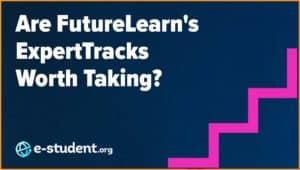The programming language R continues to gain popularity. According to TIOBE, a software QA automation company that ranks programming languages based on how often they’re searched for online, R is catching up with Python, fast. As of August 2020, R is the 8th most popular programming language (its highest position ever — in 2019, for example, it was the 20th most popular), ahead of SQL, MATLAB, and Swift (Python is third most popular, after C and Java).
So, why R? One potential reason is that universities and research institutes are turning away from commercial packages like Stata in favor of open source languages like R and Python. Another is the increase in statistical computing and data mining being used to search for a COVID-19 vaccine. The sudden interest in R could also have something to do with the fact that R is reproducible and cross-platform compatible, can connect with other languages, and has a vast user base in both academia and business (Facebook, Google, and Bank of America all use R).
The only problem? R has a reputation for being difficult to learn. As the consultant, John D. Cook said, “I have written software professionally in perhaps a dozen programming languages, and the hardest language for me to learn has been R. The language is actually fairly simple, but it is unconventional.” Luckily, with the right R programming language course, you can go from beginner to a competent R programmer in no time. Below we’ve compiled a list of the nine best R online courses that’ll help future data scientists and data analysts get to grips with one of the most powerful programming languages for statistical computing and data visualization.
Without further ado, these are the best R courses.
Best R Programming Courses
Best Overall: R Programmer (DataCamp)
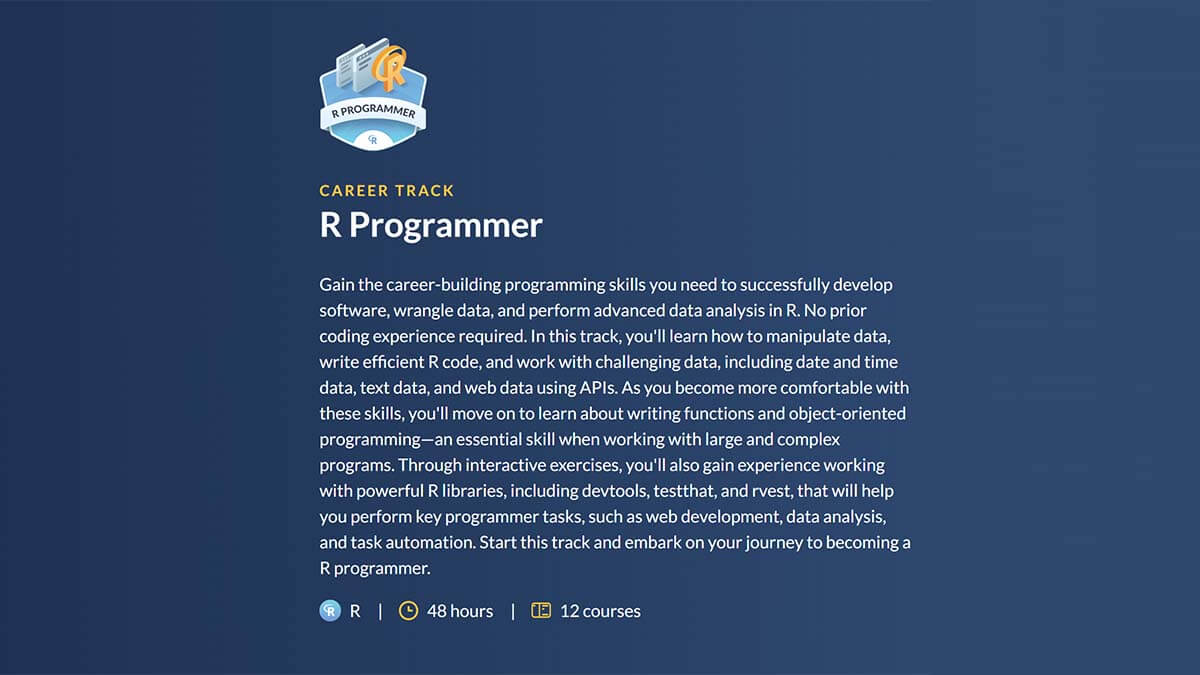
50% off Unlimited Data and AI Learning (expires 28 March 2024)
- 12 R online courses chosen by industry experts
- Hands-on exercises and case studies
- 3 projects designed by expert instructors
- No prerequisites
Cons
- Would benefit from more individual feedback on coursework
The R Programmer career track, available on DataCamp, consists of 12 courses handpicked by industry experts. The track starts off with an introduction to Tidyverse (a collection of open-source R packages) before showing you how to manipulate your data using dplyr, speed up computations with parallel programming, defensively program for errors, build an R package, and perform object-oriented programming (OOP) in R.
All of the 12 R programming courses in this program feature video lessons and hands-on exercises. Some courses also have case studies.
The program also includes three projects designed to help students solidify their knowledge. For example, after you learn how to parse and manipulate dates and times in R, you’re asked to use your new skills to analyze breathalyzer data to figure out who is drunk and when in Ames, Iowa.
Since each course takes about 4 hours to complete, you can expect to finish the entire course in about 48 hours. However, this doesn’t include the time you’ll need to spend on each project. You don’t need to have any prior experience to get started with this program.
With courses chosen by industry professionals and a ton of hands-on exercises, DataCamp’s R Programmer program is undoubtedly the best R programming language course out there. Not convinced? Because DataCamp offers the first chapter of every course for free, you can try this program before you commit to it.
Best for Beginners: Programming for Data Science with R (Udacity)

- 3 industry-relevant projects with unlimited feedback
- Auto-graded quizzes
- Personal career services
- No prior experience necessary
Cons
- Considerable time commitment at about 3 months
Learn foundational data science programming tools with Udacity’s “Programming for Data Science with R,” a self-paced program designed in collaboration with Mode, a collaborative analytics platform that combines R, Python, SQL, and visual analytics.
The program is split into three courses: ‘Introduction to SQL,’ ‘Introduction to R Programming,’ and ‘Introduction to Version Control.’ Each course is further divided into lessons. For example, ‘Introduction to R Programming’ is made up of four lessons: ‘Introduction to R,’ ‘Syntax & Data Types,’ ‘Control Flow & Functions,’ and ‘Data Visualizations & EDA.’
Each course ends with an industry-relevant project. So, at the end of ‘Introduction to R Programming,’ students have to use R to answer questions about bike-sharing data from three U.S. cities. Every project you submit is checked by an experienced reviewer who reviews your code and provides personalized feedback and additional resources for improvement. Students are entitled to unlimited submissions and feedback loops.
You can also test your understanding of specific concepts via auto-graded quizzes and find answers to your questions through ‘Knowledge,’ Udacity’s proprietary wiki. Moreover, students can also avail of personal career services.
The program takes about 3 months to complete from start to finish, provided that students dedicate around 10 hours a week to it. No prior experience with data analytics or programming is necessary to enroll in this program.
Programming for Data Science with R, which is available on Udacity, comes with industry-relevant projects graded by expert reviewers and personal career services. As such, it’s probably fair to say that it’s one of the best R online courses that will take you from being a beginner to having marketable skills in R.
Best Free Course: Introduction to R (DataCamp)
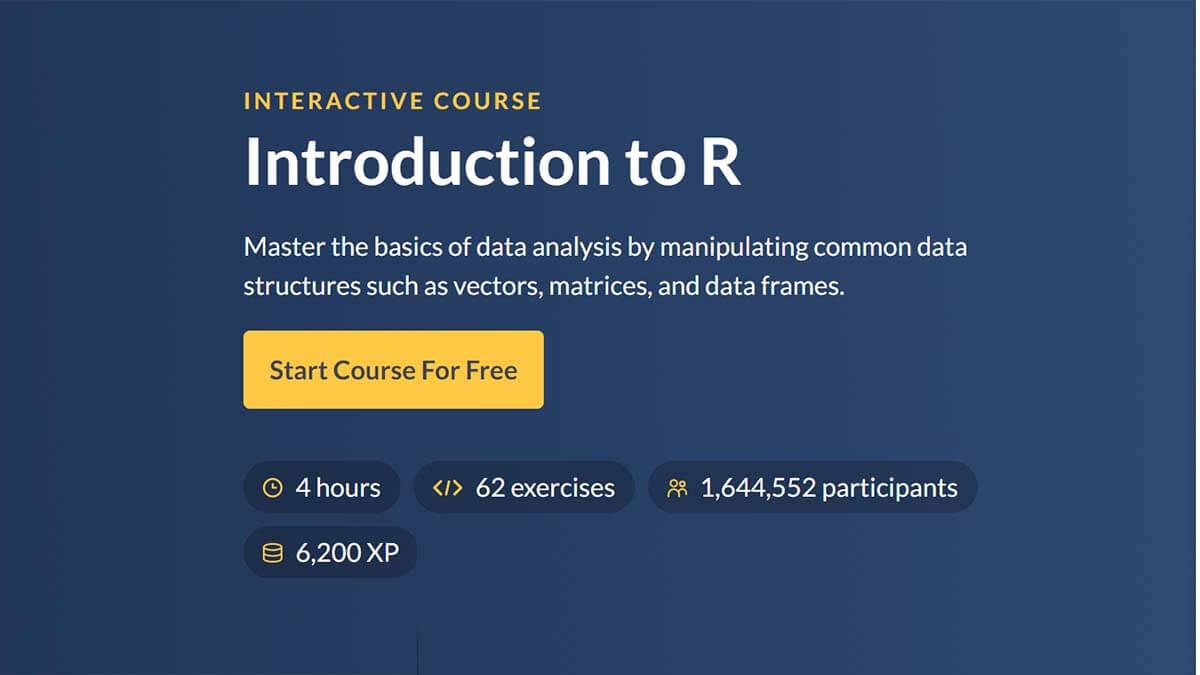
50% off Unlimited Data and AI Learning (expires 28 March 2024)
- Free R course
- No knowledge of data science necessary
- Hands-on exercises with real-world data
Cons
- No video lessons
- You don’t get enough experience writing your own code
Who said that you had to spend hundreds of dollars to pick up new skills and enhance your career? With DataCamp’s “Introduction to R,” you can get to grips with basic data structures and arithmetic operations in R at no cost at all!
This interactive course is split into six sections: Intro to Basics, Vectors, Matrices, Factors, Data frames, and Lists. Although each lesson includes short, written tutorials (there are no video lessons), the focus here is on hands-on exercises, some of which involve real-world data.
Don’t worry about getting stuck on any one exercise, though. Every exercise comes with an optional hint. If you’re still unable to progress, you can always see the full solution. That, coupled with the fact that this course has no prerequisites, makes Introduction to R great for those who are completely new to R and data science in general.
If you’re not sure whether you really need to or want to learn R, DataCamp’s Introduction to R will help you figure it out — for free. More than one million students have taken this course to date and loved it. That’s not so surprising considering that the course has countless exercises that feature real-world data, takes only four hours on average to complete, and includes R certification.
R Programming (Coursera x Johns Hopkins University)

40% ($140 USD) off your first year of Coursera Plus Annual (expires 2 December 2024)
- Shareable R certification
- Includes quizzes and practice exercises
- 7-day free trial
Cons
- Requires familiarity with regression
- Assignments are sometimes too challenging
Offered by John Hopkins University and available on Coursera, “R Programming” is a four-week program that covers the history of R, control structures, loop functions, debugging tools, simulations, and more.
The curriculum is taught via short R tutorials in the form of video lessons and readings, quizzes, and practice exercises. Note that because the assignments are fairly complex, you may need to do external research to complete them.
The program is marked as ‘Intermediate Level’ and requires knowledge of regression. Prior exposure to R may also be helpful as the content can, at times, be quite challenging. In fact, some of the topics covered in this course are usually taught in more advanced R courses.
Although there’s no option to audit this program for free, Coursera does have a 7-day free trial. Coursera also offers financial aid for students who can’t afford the course fee. Most students can expect to finish the course in about 60 hours, depending on their familiarity with R.
R Programming is another one of the best R courses and is best suited for people who either have some experience with R or are willing to do extra research. Although challenging, this R programming language course is certainly rewarding and comes with R certification.
R Programming A-Z: R For Data Science With Real Exercises! (Udemy)
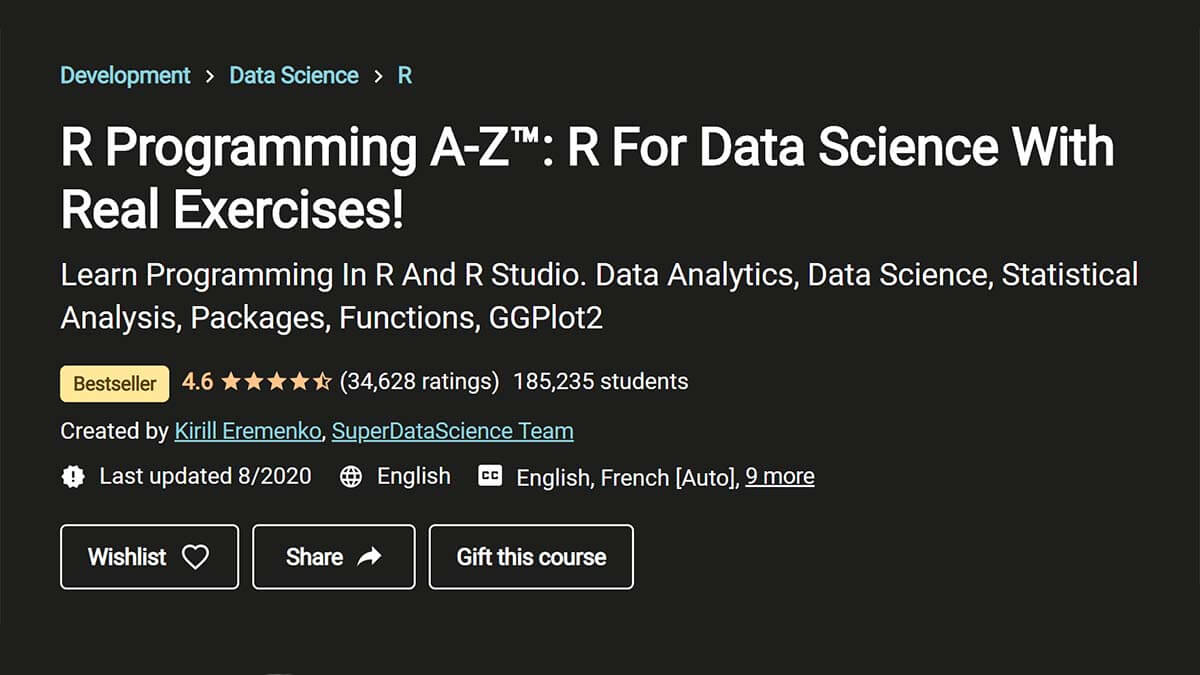
New customer offer! Top courses from $14.99 when you first visit Udemy (expires 31 March 2024).
- Beginner-friendly
- Can be completed in just 10 hours
- Well-structured and easy to follow
- Includes short quizzes and homework assignments
Cons
- Could use more practice exercises
Udemy’s “R Programming A-Z” is a great introductory program to using R in data science that takes just over 10 hours to complete. The content includes core programming principles, fundamentals of R, matrices, data frames, and advanced visualizations with ggplot2. In total, students get access to 82 lectures and 6 articles.
Because the program is incredibly well designed, it’s super easy to follow. Every course starts with an overview of what’s to come and ends with a quick recap, a short quiz, and a homework assignment (which includes a real-world data set). Since the lecturer provides homework solutions, you’re never left in the dark about whether you’re on the right track.
It also helps that the curriculum is taught by Kirill Eremenko, a data science management consultant and a well-known data science instructor on Udemy. Students have noted that Eremenko is passionate about data science and that his explanations are detailed and easy to understand.
Udemy’s R Programming A-Z: R for Data Science with Real Exercises! is the best R online class to start your journey as a data scientist. The program begins with the very basics and progresses step by step, ensuring that your R learning experience doesn’t get too overwhelming.
Data Science: R Basics (edX x Harvard)
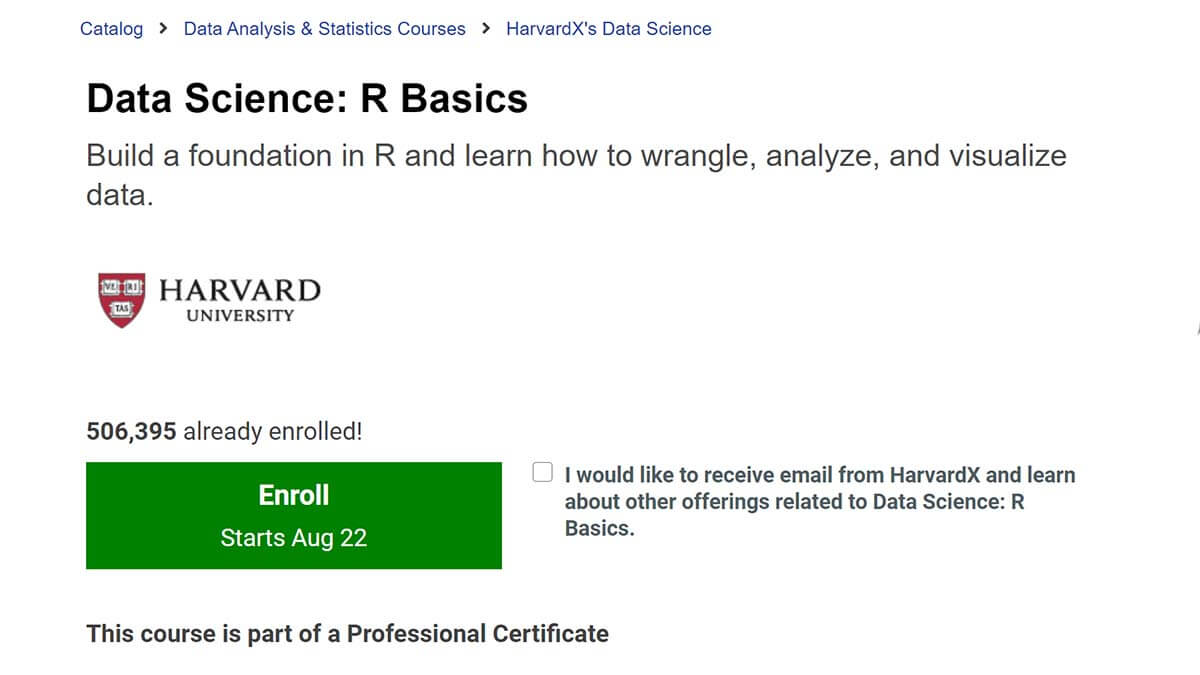
- Offered by Harvard University
- Includes a free textbook
- Assignments provided via DataCamp
- Prior experience not required
- You can audit course content for free
Cons
- Would benefit from more individual feedback on coursework
The “Data Science: R Basics” course is the first part of HarvardX’s (free online courses offered by the Harvard University of edX) Professional Certificate Program in Data Science (which consists of nine courses).
At the end of this course, students should know how to import R packages and then use them in R scripts. They should also be able to work with vectors, sort data, filter data based on condition, and apply general programming features like “for loop” commands.
Course material is taught by Rafael Irizarry, Professor of Biostatistics at Harvard University, via short video lectures and assessments. Course assignments are offered via DataCamp’s interactive web-based programming interface. At the end of each section, there’s a final assessment that tests your knowledge of all the topics you’ve just covered. The course also comes with a free textbook.
Note that this course doesn’t delve into more advanced topics such as probability, regression, and machine learning (these are covered later in the series).
Most students can expect to complete the course in about eight weeks, as long as they spend one to two hours each week learning. That being said, if you have some programming experience, you might finish it much quicker. However, prior experience isn’t necessary.
You can audit this course for free, but you won’t get graded assignments, nor will you receive R certification at the end of the course.
Taking a course designed by Harvard University lecturers is always worthwhile. EdX’s R Basics is no exception and is the first course in HarvardX’s Professional Certificate Program in Data Science that will teach you the basics of using R and coding in R.
R Tutorial (Tutorialspoint)
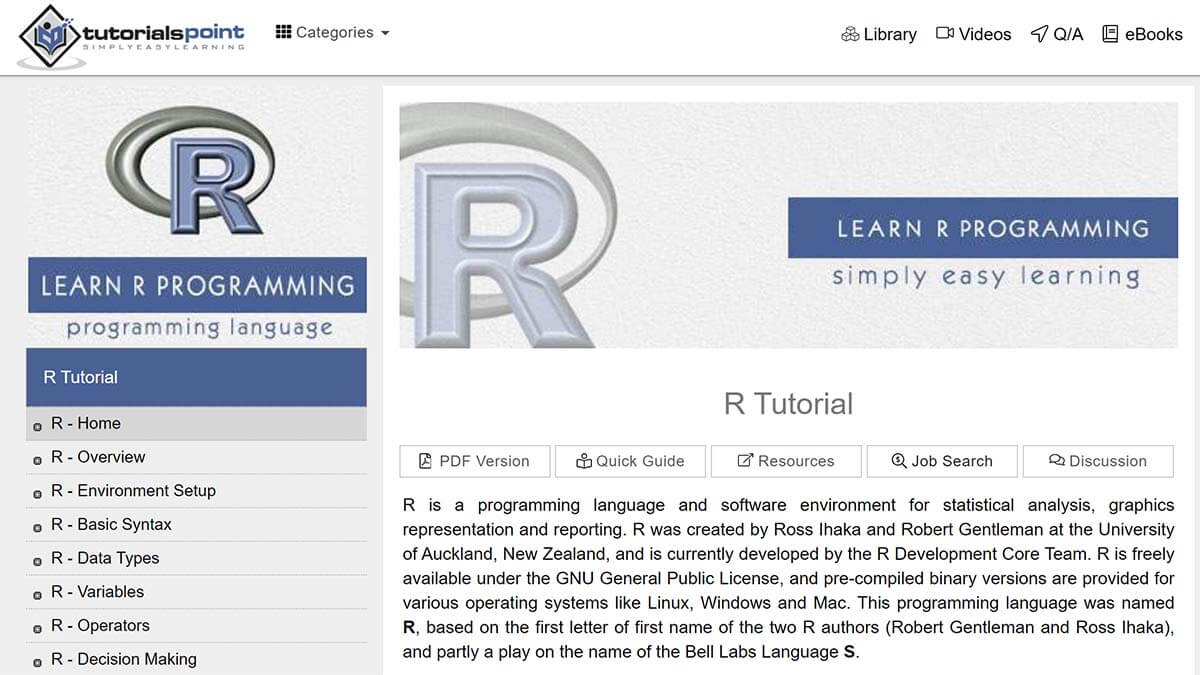
- Free
- No prerequisites
- Great as a reference
- Available in PDF
Cons
- Text-based
As the name probably makes it quite clear, Tutorialspoint is a site dedicated to sharing knowledge about various programming languages, including R.
The R Tutorial is split into four main sections. The first section (‘R Tutorial’) covers things like the history of R, data types, variables, loops, matrices, factors, and data frames. In contrast, the second section (‘R Data Interfaces’) teaches you how to read CSV files, Excel files, XML files, Web Data, and similar. The third section (‘R Charts and Graphs) is all about charts and graphs, including pie charts, histograms, and line graphs. Finally, the fourth section (‘R Statistics Examples’) goes over concepts such as linear regression, time series analysis, and decision tree.
There’s also a section dedicated to useful resources (like a quick guide to R) and selected reading (including ‘Developer’s Best Practices’ and ‘Computer Glossary.’)
However, bear in mind that all of the free content is text-based (the site does have R video tutorials, but you’ll need to pay for those). As such, even though there are no prerequisites (other than knowledge of computer programming terminologies) to taking this course, it mightn’t be the best place for learning R from scratch. Instead, many people use the site as a reference.
Tutorialspoint’s R Tutorial is an excellent beginner reference text and is also useful for recalling bits of information you might have forgotten. Best of all, it’s completely free and comes with helpful resources, like a list of questions you might be asked during an interview for a data scientist position.
Data Science and Machine Learning Bootcamp with R (Udemy)
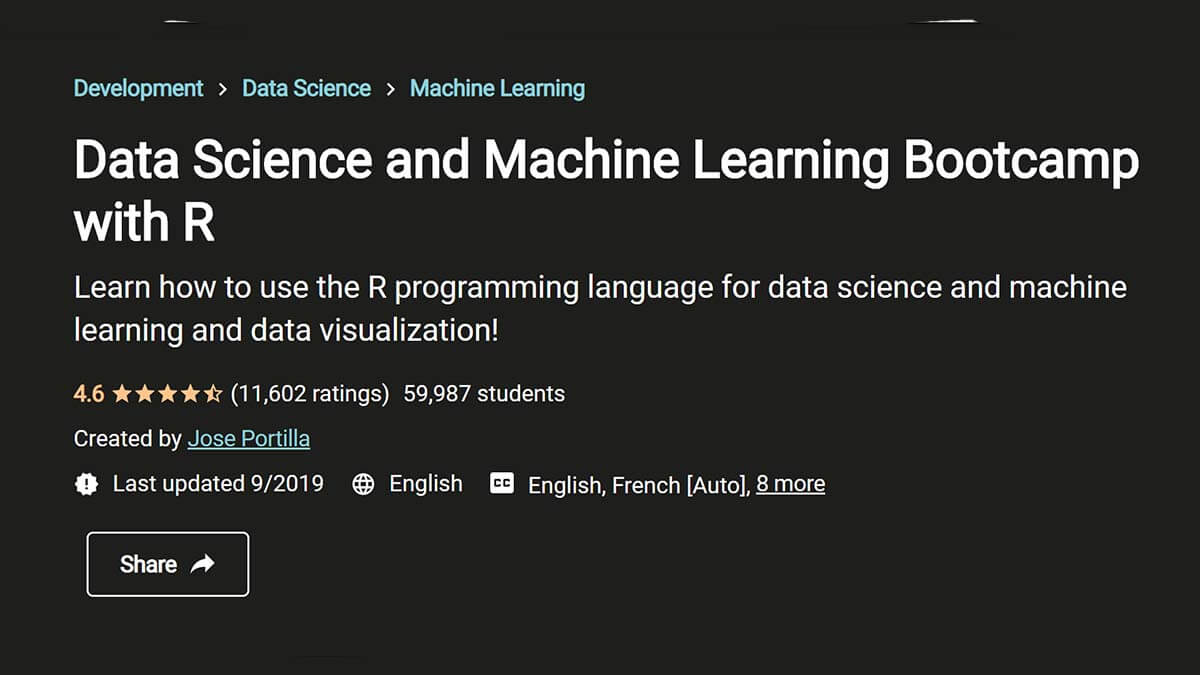
New customer offer! Top courses from $14.99 when you first visit Udemy (expires 31 March 2024).
- Taught by one of the most popular Udemy instructors
- Includes challenging projects
- No prior experience necessary
- Comes with subtitles in various languages
Cons
- Machine learning section could be improved upon
Created by Jose Portilla, one of the most popular Udemy instructors, the “Data Science and Machine Learning Bootcamp with R” is a comprehensive course consisting of 127 lectures, 17.5 hours of on-demand video, 8 articles, and 3 downloadable resources.
During the course, Portilla delves into topics such as matrices, data frames, lists, data manipulation, data visualization, and machine learning (including linear regression, decision trees, random forests, neural nets and deep learning, and support vector machines). The lectures are followed by readings and challenging projects to help you apply what you’ve learned.
You don’t need to have any previous experience with programming to take this course. Portilla breaks down every concept thoroughly, which means that even those who don’t know much about data science will come out of the course with advanced knowledge of R and machine learning.
If you want to understand machine learning, this course is for you. The course instructor explains everything clearly and concisely and gives students projects that help build confidence.
R for Data Science: Lunchbreak Lessons (LinkedIn Learning)
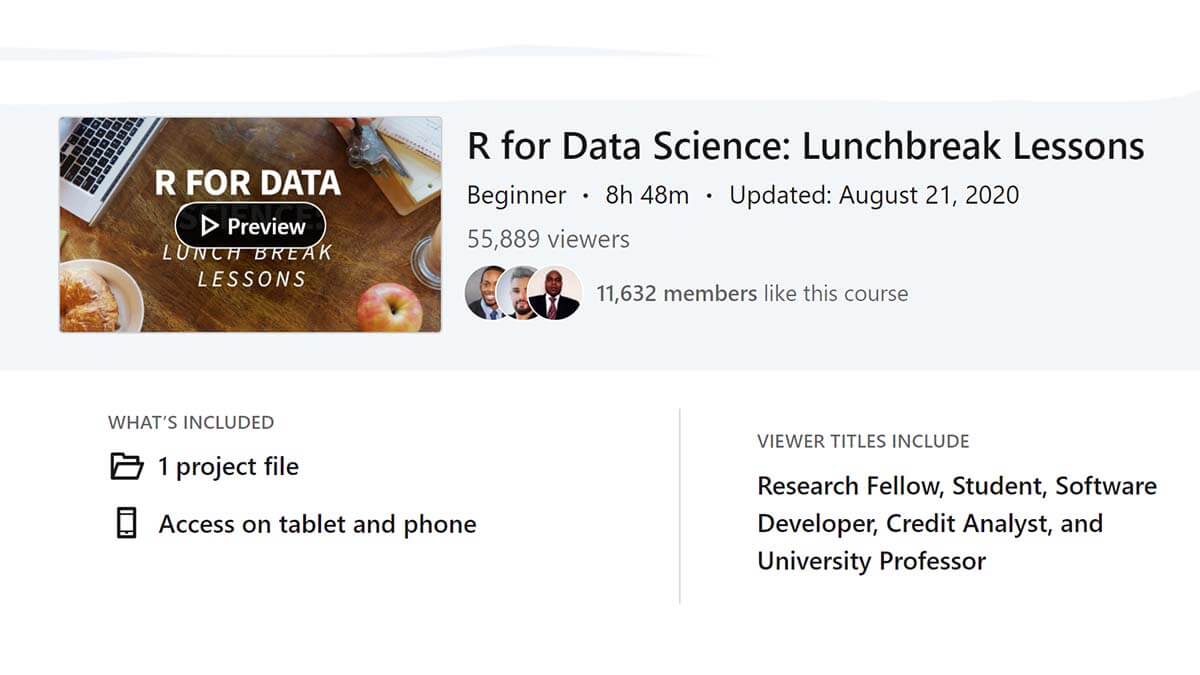
- 30-day free trial
- Bite-sized learning modules
- Ongoing series
- Under 9 hours long
Cons
- Lack of exercises and projects
It doesn’t matter whether you’re new to data science or if you’re an experienced programmer. LinkedIn’s “R for Data Science: Lunch Break Lessons” claims that students of all levels will find “pearls of wisdom” throughout this short but detailed course.
As part of this R online class, you will learn about useful R tools and libraries, master R basics, discover ways to improve existing R code, and explore new features. However, because the series is ongoing and new lessons are added weekly, students don’t receive a certificate of completion.
If you notice that a specific lesson covers information you’re already familiar with the course instructor urges you to skip to the next lesson. Each lesson is relatively short (the longest one is about eight minutes long), so you can “grab what you need and get back to work.”
In addition to the video lessons, students also get one project file and access to ‘Learning Groups,’ unlisted learning communities where learners can chat with other students and instructors.
If you’re super busy and don’t have much time to spend learning a new programming language, LinkedIn Learning’s “R for Data Science: Lunch Break Lessons” is ideal. Since this R programming language course is divided into short lessons, you can make use of any spare moments to keep learning. By the way, LinkedIn Learning offers a one-month free Premium trial, so you can try this course for free.
FAQs
🤔 What is the best way to learn R?
One of the best ways to learn R is to use it. However, if you don’t even know where to start or need help to install R and RStudio and get to grips with the basics, a good R programming language course can point you in the right direction.
💢 Is R easy or difficult to learn?
R is known for having a steep learning curve. That being said, most online R courses are comprehensive and easy to follow, so you should have no problem mastering this open-source programming language.
🙋♂️ Why is it worth to learn R?
One of the main reasons it’s worth learning R is because it’s the standard language for data analysis and statistics. It’s also open-source and freely available and has widespread acclaim (at least 2 million people use it). Plus, the average U.S.-based R programmer makes over $70,000 a year!


